In the comments following my recent post about foot strike patterns of runners from the days before the modern running shoe, somebody asked if I had any video of Abebe Bikila’s stride. After a bit of searching on YouTube, I came across the following clip – jump to the 1:15 mark and you get a really nice view.
In the video, Bikila seems to exhibit a very mild heel strike in his Puma shoes on the way to setting the marathon world record in the 1964 Tokyo Olympics (maybe a few midfoot strikes mixed in for good measure). Granted, his form looks otherwise flawless – no overstriding here – but it just goes to show that even a great runner who won an Olympic Marathon barefoot (1960 in Rome) can be a “heel striker” by the technical definition of the phrase. If you don’t believe me, download the video using keepvid.com and go frame by frame.
Based upon my own observation of 1000+ slow motion videos of runners, it’s become pretty clear to me that not all heel strikes are created equally. There is a spectrum from extreme dorsiflexion to very mild landings like Bikila’s (check out the photo below), and perhaps it’s time we stop lumping them all together into one category. Heel striking is a spectrum, as is forefoot striking, and other aspects of what the limbs are doing might be just as important. Studying running form has been a constant learning process for me, and if there’s one thing I have come to understand, it’s that variation is rampant, and that much as Amby Burfoot suggested in a recent post of his own, generalizations about particular aspects of form should be made with caution.

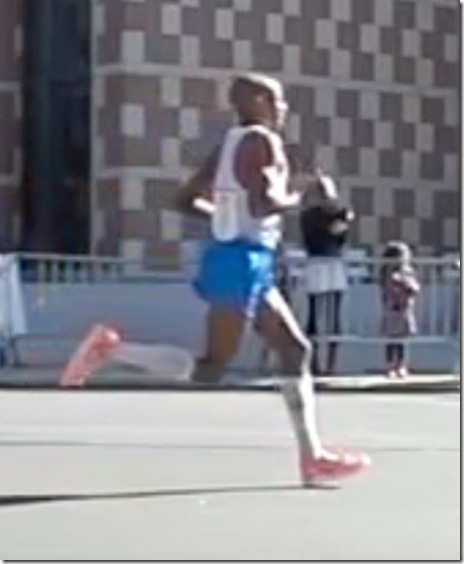
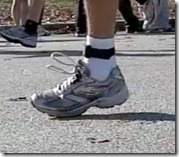
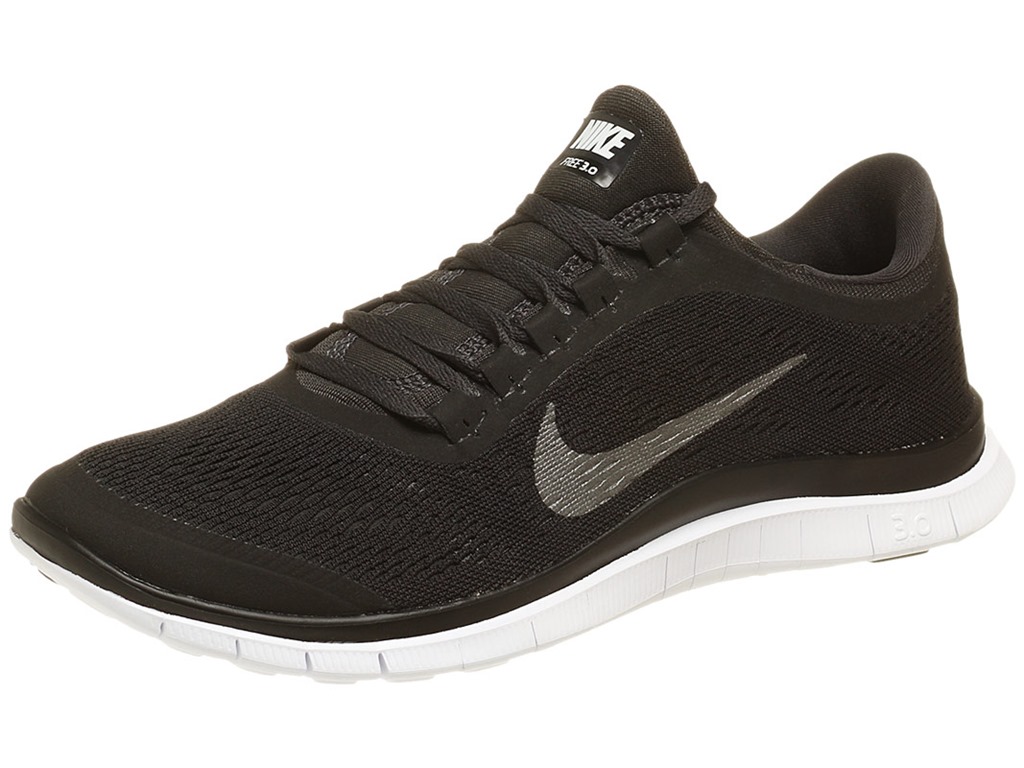
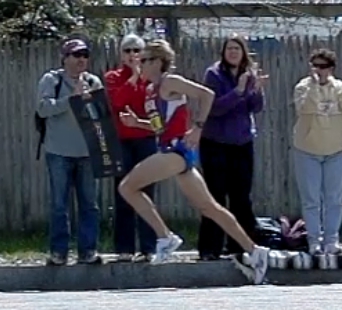
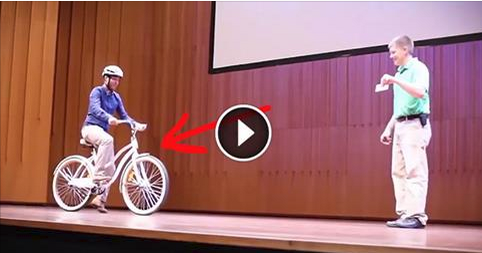














Tt would seem to obviously be important what you do with the foot/leg upon impact.
If you ‘stiff leg’ it, yes, big heel forces, but if you have a powerful paw-back and don’t really load the foot for a few ms, perhaps all heel strikes are not equal?
Very mild heel strikers may be doing more of the latter…?
I suspect you are probably right – lots of variation in how the foot
approaches the ground. Bikila is clearly starting to pull his foot back,
others do not.
Another interesting post, thanks. Not all heel strikes are the same, that’s perfectly clear! I wonder if from force plate measurements whether anyone has attempted to correlate the transient impact force to the amount of bend in the leg at the moment of initial ground contact? Of course, consistent with your prior post the transient impact force, even if high, is likely to be much more easily born via muscle tissue than bone, cartilage and ligament (as would be the case with more of a straight leg upon impact).
It would also be fascinating to examine differences in the Bikala’s running stride between his barefoot Rome Olympic marathon run in ’60 and this excellent ’64 shod footage (I’d speculate that a he owed at least a portion of the ~4-minute faster shod Tokyo performance owing to slightly extending his stride via relying on the heel resiliency of his Puma shoes.)
Mark,
Good questions – can’t think of a study that looks at leg positioning and
forces off the top of my head. Heiderscheit’s 2011 paper did look at stride
length, stride rate, and impact at the knee and hip:
link to runblogger.com…
Need to go try an dig up some barefoot footage of Bikila now!
Pete
hey mark,
jay dicharry (UVA) is one of the experts in this realm. would be interesting to ask him. he did a blog post a while back on impact transients for various foot strikes. the point of the article was to try to land closer to your center of mass rather than further away.
some “heel strikers” actually have low impact transients and some “forefoot strikers” actually have high impact transients. normally, it’s the reverse, but it can happen this way.
so i think jay’s post backs up what you and everyone are saying here…not all heel strikes are the same.
link to post: http://uvaendurosport.wordpres…
link to youtube.com…
Here is some barefoot bilika, near end is good but needs to be slowed down
His arms are also crossing the centerline of his body. Maybe in this case he is pretty worked and starting to get sloppy?
When he crosses the finish line he looks as fresh as can be, even does a
little dance/stretch routine on the infield!
I’m inclined to agree with you. Based on the videos I’ve watched of Abebe Bikila, when he ran barefoot, he landed on his forefoot, and when he ran in shoes, he landed on his heels. I’ve seen many other old videos of world class distance runners landing on their heels as well. If the runner is wearing shoes, and is not landing too far out in front of his or her body, I think it is clear that some people can run very well when landing on their heels. After all, there is much more to good running technique than heel strike vs forefoot/midfoot strike.
I agree – his form looks great.
His heel touched ever so slightly for the first couple of steps but the rest are midfoot touches with a definite forefoot absorption style so I’d still put him in the forefoot style category.
The other thing that I noticed is that he might be running downhill which might explain the few heel touches.
I would need to see a few more videos of him running on level ground before labelling him as a heel striker.
By the technical definition of the phrase, heel striking involves initial
contact on the heel or rear 1/3 of the shoe. By this definition, almost all
of his strikes are heel strikes. He is nowhere near a forefoot striker here.
But, I agree that he is probably not loading much on the heel, but that was
the point I was trying to make – heel striking is not always evil.
My interpretation of the definition is not where contact is made but instead defined by which 1/3 of the foot absorbed the greatest amount of impact. In fact, I would even consider someone who touches the ground with their forefoot first but then absorbs the impact on the heels to be a heel striker. I think of it more in terms of calf activation and it’s role in absorbing impact.
Rich,
From Lieberman et al., 2010: “Running can be most injurious at the moment
the foot collides with the ground. This collision can occur in three ways: a
rear-foot
strike (RFS), in which the heel lands first; a mid-foot strike (MFS), in
which the heel and ball of the foot land simultaneously; and a forefoot
strike (FFS), in which the ball of the foot lands before the heel comes
down.” Hasegawa et al., 2007 specifically define foot strike as the point of
first contact. Contact and loading are different things.These definitions
are pretty standard in the literature.
Maybe then we need a better definition of the forms that we’re trying to describe. Where the foot makes initial contact is not that interesting to me because I think it plays a minor role in how the body absorbs impact and we can see this in the video where Bikila touches with his heel but seems to absorb the impact while he’s on his forefoot. Maybe the benefits of forefoot striking could be better described by the amount of calf muscle activation during impact.
It’s simply the difference between kinematics and kinetics – you can’t see
the forces, which is why so many people are trying to correlate the various
footstrike patterns with the forces generated under the foot. Most people
don’t have access to force equipment, but filming gait is fairly easy. My
basic point in this post is that you can have a heel strike, but that
doesn’t necessarily mean that you have bad form. That’s what I meant when I
said not all heel strikes are created equally – the forces under Bikila’s
feet are probably much different than those of an overstriding heel masher.
Yes, and that’s a good point and it’s something that I hadn’t really considered before. Now that you’ve shown this, it looks like we need to redefine what good form is, which might or might not have anything to do with which 1/3 of the foot touched the ground first. This is interesting and I hope we can see more studies on how much and which muscles activate during impact.
For a true forefoot striker, see Moses Mosop (closer to camera) in this
video: link to youtube.com…
Wow, never thought my request would spark a blog. Perhaps we could compare his shod stride with his unshod stride. It is for this reason that I do not wear structured shoes for running. In this video, I think he is a back of the mid foot striker, considering the degree to which many heel strikers slam the edge of their heel into the ground.
I’ve been enjoying your posts this week, Pete. Thoughtful an thorough analysis as always. On March 28, I wrote a blog post with YouTube vids of various sprinters, plus Herb Elliott, unshod Abebe Bikila in the ’60 Olympics and 2 vids of an unshod (and very fast) Zola Budd on the track. Here is the link in case you want to look at or share any of these. link to tiny.cc
Zola, by the way now lives in North Carolina and is making a comeback in Masters Track!Thank you for your good food for thought.Robin Judice, PT, CSCSwww.blazingbayou.com
Pete,
I have been enjoying your posts this past week. You are ~ as always ~ thorough and thoughtful in your writing.
You or you readers may want to see some of the video clips I compiled for a blog post back on March 28. It includes sprinters, middle distance and long distance YouTube clips: Including Herb Elliott, an unshod Abebe Bikila in the ’60 Olympics and a very fast unshod Zola Budd on the track. Here’s the link to my post: link to tiny.cc
Zola, as you may know, is married with children, lives in North Carolina and has resumed her competitive career in Masters Track!
Thank you for the time you to research and share high quality information.
Robin Judice, PT, CSCS
http://www.blazingbayou.com
Robin,
Thanks for sharing, good stuff! How did you like the conference in Shepherdstown?
Pete
Sent from my iPad
It was fabulous, Pete! I am still absorbing, consolidating my notes, thinking about everything and practicing what I learned. Mark was so great to host this, bring together Blaise and all the other great speakers. I highly recommend the course to runners, coaches, PT’s, MD’s, running shoe store owners. There was a lot of good information shared both from the teachers and the class.
I agree- had a blast at the course in January. Really eye opening.
“…other aspects of what the limbs are doing might be just as important” I’d say “are more important.” When helping someone to improve their form, don’t worry about how the feet are striking the ground. Start with what the hips, core, and upper legs are doing. Also, worth noting that individual runners vary their form and foot-strike depending on how fast they happen to be running, the surface (soft or hard), and whether they’re running on the flat, uphill or downhill.
All good points – not sure exactly where this footage was taken in the race.
Thanks to Robin Judice for the YouTube link (link to youtube.com…. The footage from 5:00-6:30 clearly shows Bikala’s barefoot 1960 Rome stride well. Comparing same versus his shod 1964 Tokyo performance allows us to see his stride adaptations facilitated by his wearing Puma’s (what we would today describe as a minimalist neutral shoe). As you’ve already noted Bikila’s shod versus unshod contact phase is clearly much more of a heel versus his prior midfoot strike, and if I’m not mistaken may also have a slightly slower leg turnover that’s more than made-up for via a longer stride evident both on the contact and the propulsive phases of his gait. Both in ’60 and ’64 Bikala’s stride is a thing of beauty, but as his shod performance is nearly 4-minutes faster this helps answer the question why nobody is expected to run London’s Olympics barefoot!
Hard to say for sure, but does look like a flatter landing barefoot. I’m
very hesitant to make any conclusions about relative times between Rome 1960
and 1964 – different courses, different races. Half of the Rome course was
apparently on an uneven cobblestoned road – that fact that he put up the
time he did barefoot is simply amazing. It’s also worth remembering that he
won both races, so his shod competition in Rome didn’t do better than him.
It’s quite possible that 1960 was simply a slower race for any number of
reasons, so comparisons between the two are sketchy at best.
One thing that I *think* may be important in conversations about form is this:
To generalize by comparing oneself to a world champion may not be the best idea.
That is, what you do when you’re running at about 13mph, and weigh about 110 pounds is NOT the same as what you do when you’re running at 8-9mph and weigh 175.
My mechanics when I’m sprinting, full-speed, are different than when I’m at even 95% speed… and different from someone who is merely trying to run fast and doesn’t top out at 23mph. Similar, but not the same.
Maybe even more important but never adressed, the lower leg slash upper leg ratio varies and makes for different kinds of stride, so why should heelstrikers with various ratio don’t have various heelstrike patterns? And on top of that there’s also the upper body versus lower body ratio, loook at a guy like 800 meters champ Kirwa Yego, the guy’s a midget in centimeters but he’s 80 % legs and 10 % torso…
Yep, variability is the norm, which is why blanket generalizations about form are so hard to make.
Sent from my iPad
Steve,
I agree to an extent, but if you look at elites running at easy pace, their from is still pretty nice compared to people in big heeled shoes. Lots of things will change with speed for sure, but one can still run very badly regardless of pace (or very well for that matter).
Sent from my iPad
Pete,
Beautiful vintage video. Robin, great stuff and thanks for coming to our conference last weekend in Shepherdstown. Bikila is perfect here for the conditions and having shoes. his lower leg is not past perpendicular to ground, he rolls forward from his soft heel touchdown, pronates naturally to coil and load the achilles spring, and recoils off the ground at a cadence above 180 (this is natural muscle tendon elastic recoil frequency). if we had force plates we would not see a high impact transient or loading rate.
Now this is heel striking as is every picture in Asics paper brochure
link to asicsamerica.com…
leg way in front with dorsiflexed foot and locked knee.
Run with a jump rope and try to land like this….you cannot.a perfect drill for balance, rhythm, and proper landing position. it is fun too!
Dr. Mark Cucuzzella
trtreads.org
I agree completely Mark, I’ve taken to looking at the lower leg myself, and when you have a shoe with a big cushioned heel I think you are far more likely to see the foot land way out in front of the knee. The paw back is something I’m interested in too – whether the foot is retracting prior to contact may b a big part of this.
Sent from my iPad
Hi Pete
Thanks for a great post. I myself have changed my footstrike from a heel strike to a midfoot strike because of recurrent knee injuries. Now, while I cannot imagine ever going back being a heel striker in conventional shoes with a built up heel, I feel the debate on heel/midfoot striking has been much to polarized, and I fully agree with you that foot strike develops along a continuum from extreme heel striking to forefoot/toe striking. It is counterproductive and much too reductive to categorize runners as either heel or midfoot strikers.
Br. Peter Pedersen, Denmark
I agree, as I have seen from any number of high level marathon runners, you can do quite well with a mild heel strike. What I don’t see most of these guys doing is the big extension at the knee so that the foot lands way in front of the knee at contact. I’m afraid that heel strike has become a bit of a dirty word so to speak, and it forces people to push too hard and hurt themselves by forcing the opposite extreme. I tend to believe that over striding is the bigger problem, and that foot strike is just one potential piece of that puzzle.
Pete
Sent from my iPad
Good stuff (as usual) Pete! The thing that I chew on often with all of this and with the video analyses on the runners in our clinic is the whole combination of footstrike type, along with the degree of knee flexion and position of the tibia compared to vertical at footstrike and early stance. I’m not aware of any formal definition of overstriding at this point but I do try to quantify this by measuring the distance from the approximated vertical line through the center of mass of the trunk to the rearmost point of the footstrike. I generally find that if this distance is more than 30cm or so, there’s more of a correlation with knee or lower leg injury. ( I probably need to think more about tightening the criteria on this by taking account of the runner’s leg length (either measured on the table or the “virtual” leg length while running with the distance from trochanter to heel (regardless of how flexed the knee is at footstrike) and looking at the ratio between the two). Fortunately, Dartfish makes this relatively easy to do – I just have to make sure to have my meter references on the ground just behind the path of the runners for calibration.
Perhaps Benno Nigg’s assumption is correct, that heel striking is no less natural than midfoot/forefoot, but follows naturally if the ground is soft enough (or the shoe cushioned enough). So that we should not consider heel-striking as unnatural, and not raise midfoot/forefoot as the only true natural way to run?
I’d like to see a test when habitually barefoot runners run on really soft ground. My guess is that they’ll still forefoot strike though…
But the thing to remember is that lots of runners do a lot of their
miles on very hard surfaces, where they would surely midfoot or more
likely forefoot strike if barefoot. But, the shoes that we are sold
allow us to do things on those surfaces that the body seems to not be
meant to do. That to me is the big question – what is the effect of
this? I watch my kids run, and they mix their foot strikes quite a bit
depending on surface, and whether they are shod or barefoot.
Another great discussion and great commentary from everyone. I agree with many of the comments below that running style is a far more complex biomechanical process. I also think that running efficiently, while perhaps in some cases similar, is something that is unique to each individual. Having watched the recent Boston Marathon and seeing how variable so many of the styles are amongst the elite runners I am truly intrigued. Each of us N=1’rs is probably checking out this blog to find that holy grail of individual running efficiency. I am constantly experimenting with small components of my form in order to improve. In no way will I ever approach the elites, but I, like many others enjoy the journey to running for a long long time.
Hey Pete,
This is where the term “proprioceptive heel strike” needs to come in. Bikila does NOT exhibit a heel strike he meerly tries to feel where the ground is, when he first weight bears his weight is on his forefoot. My definition of a “heel striker” is not someone whose heel hits the ground first but rather someone who weight bears through his heel.
I forgot to add… that obviously, with shoes, he needs to hit the ground a little harder with his heel to transfer the information to his bidy that his foot has reached the ground… I don’t like to say that he is “landing” on his heel, I don’t think he is weight bearing through the heel at all.
Thanks for the post, Take care Pete
Sean,
Proprioreceptive heel strike is what I would call it as well. Foot strike is consistently defined in the literature as point of first contact, so to be consistent that is why I call this a heel strike. Nut, as we are discovering, foot strike is a spectrum rather than a set of categories, and forces do not always correlate with kinematics. I would also point out that if you make contact on the heel, it will cause some torque about the ankle forcing the foot to plantar flex. You can see this a few times in the Bikila video.
Hey Pete
Thanks for your great post. Personally, I have moved away from the heel strike, midfoot strike footstrike because of recurring knee injuries. Now, when I can not imagine going back to the heel striker in the conventional shoes with heel constructed, I feel the discussion on the heel / midfoot striking is much more polarized, and I fully agree that the strike foot to develop along a continuum of Extreme foot strikes the heel / toe surprising. And ‘frowned upon, and runners too simplistic classified as a heel or midfoot strikers.
Kamagra
Kamagra
This is a really interesting post (and great video find!), Pete. And the discussion below is good — I definitely agree with the sentiment that good or bad form is determined by much more than footstrike.
Permit me, though, to offer a gentle critique of the line of argument in some of the comments that seems to go: “Oh, sure, Bikila’s heel touches the ground first — but he’s not a ‘heel striker.’ Look how beautiful his form is! He’s just caressing the ground with his heel before putting his weight down on his midfoot! When we talk about ‘heel striking,’ we’re talking about those elephants who are massively overstriding and dorsiflexing as if they’re trying to touch their shins with their toes, like in the photos you posted above.”
So the argument is:
(a) Touching your heel to the ground first while overstriding is BAD. We call that “heel striking.”
(b) Touching your heel to the ground first while not overstriding is fine. That’s not “heel striking.”
So actually, what part of your foot touches the ground first doesn’t tell us anything. Instead, as Heiderscheit’s study argued, overstriding is the villain — and the characteristic with diagnostic power. And from there, I’d suggest that perhaps conventional running shoes don’t FORCE you to run badly (with the exceptional of over-the-top motion control models, maybe). They PERMIT you to run badly. To me, there’s a pretty big difference between those two statements — but it’s the former statement that seems to get most of the attention.
First of all, I agree with you completely about the concept of foot strike. It is where the foot makes first contact with the ground, period. It has a very consistent definition in the literature, and to redefine it to meet one’s own conception of what is happening makes no sense. It is a spectrum more than a set of categories as well, which is where we run into trouble. Extremes at either end are probably equally problematic.
I think the point is that there are lots of potential combinations of foot position and leg position that can occur at foot strike. I’d disagree with the statement that foot strike doesn’t matter, it just depends on a variety of factors just how much it matters. The position of the foot on contact is going to impact torque generation about the ankle, which muscles are used to absorb shock, and probably how forces are applied up the leg. So to say that foot strike doesn’t matter at all is just as much a stretch as saying that it is critical in all cases. I get emails from people who are frustrated because they can’t kick their heel strike, and my response more often than not is to not worry about it. If you are running well and not injured, it may just not be that big of a deal. If you have problems, it is just one factor consider, but probably not the only one, and maybe not the most important one.
Modern shoes allow bad form – that’s a good way to put it, but I personally would go so far as to say that any shoe with a 12mm lift of cushion under the heel is going to more often than not encourage bad form, and make over striding much more likely. You can heel strike barefoot, as Lieberman showed in some of his unshod Kenyans, but I very much doubt they were extending the knee and reaching out with the foot at contact.
Sent from my iPad
Perhaps a better way to say it is: the higher the heel the more difficult it is to land forefoot or midfoot. Actually, “permit” is not too bad a word to use – just like soft grass or sand or mud encourages a heel strike. I think the foot knows when the ground is soft and changes the required strike as necessary. Perhaps cushioned shoes are confusing our brains. The foot feels soft and cushy so it heel strikes but then Whamo! your body hits the pavement.
In the pictures above and when analyzing strike pattern one must look at the knee and ankle as well. Bikila’s knee is really bent when he’s heel striking – perhaps he was just tired in that section of the race and over striding just a bit. The Vibram heel striker in the pictures has a completely straight leg – no wonder his quads locked up.
Finally, I think looking at elite runners in races is a bit hard to extrapolate to the rest of us. Even they are going to do a lot of things in a race they wouldn’t do in training in order to win. What gets me is when I see the casual jogger out there in normal shoes but with a very short stride and their foot is right under their center of gravity. This tells me the word is not getting out. If they are running like that there is no reason they need cushy shoes. Get them into some minimalist shoes, huaraches, or even barefoot and let them enjoy running a bit more (because 9 times out of 10 when they are running like that they also look like they are undergoing some kind of torture).
Putting things into context again, take a look at the 4 runners that I
videotaped here at mile 6 of the Manchester City Marathon in 2009 – quite a
bit of variation!:
link to youtube.com…
The first and third runners need to get into some Newtons or Altras if they like cushioning – or Merrells or VFFs if they don’t really need cushioning. The 2nd and 4th runners need to work on form or they are going to end up injured.
“What gets me is when I see the casual jogger out there in normal shoes
but with a very short stride and their foot is right under their center
of gravity… If they are
running like that there is no reason they need cushy shoes.”
I don’t understand this reasoning. If you see someone running with basically “perfect” form in normal shoes, that’s somehow bad? Isn’t the goal to develop good (i.e. injury-minimizing and speed-maximizing) form? If they’ve already achieved that, what’s the incentive to change?
I will second all of the “great post” comments. Perhaps you could provide some historical context. My understanding is that Abebe was in great shape leading up to the 68 Olympics, which he pulled out at 17km because of an. I have seen the injury cited to a broken bone in the foot and a knee injury. If you have any insight that would be great. Happy 4th!
I may not know anything about the actual science of running, but watching Bikila run is poetry in motion. LOVED watching the clip!!
Thanks, Pete!